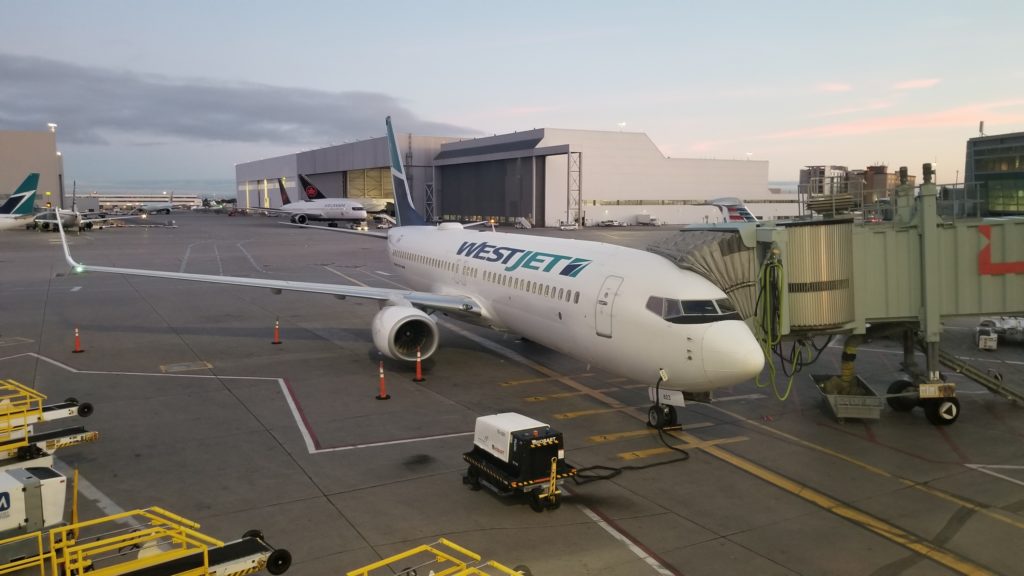WestJet has announced plans to bring SpaceX’s Ku-band Low Earth Orbit (LEO) satellite-powered Starlink Aviation broadband connectivity to its Boeing 737 narrowbodies and Boeing 787 widebodies — and offer the service for free to members of its loyalty program.
The news is a blow to WestJet’s longtime incumbent provider Panasonic Avionics, which supports the Canadian operator’s pay-per-usage onboard Internet service with a legacy Ku-band geostationary (GEO) satcom solution. Panasonic has also seen customer ZIPAIR announce plans to defect to Starlink.
“This new platform will take flight before the end of 2024, with plans to complete the installation on WestJet’s modern narrowbody fleet by the end of 2025,” reveals WestJet in a statement. “All widebody aircraft are planned to be upgraded by the end of 2026.”
Financial terms have not been disclosed but the arrangement will see the free Wi-Fi service sponsored by Canadian telco TELUS and delivered by Starlink under a multi-year strategic partnership that WestJet promises “will transform the inflight experience for WestJet guests” and set “a new standard in the Canadian airline industry”.
Access to the new inflight service will be exclusively provided to WestJet Rewards members free of charge. The low-latency LEO satcom-based IFC solution will enable every guest onboard “to live-stream videos or online game direct from their devices as if they were at home”, says WestJet.
Headquartered in Calgary, WestJet is largely a Boeing 737 operator, flying a mixture of 737NGs and MAX twinjets. But it also operates seven Boeing 787s.
During the late-May Aircraft Interiors Expo in Hamburg, SpaceX revealed that 700-plus aircraft had committed to Starlink. That figure has rocketed up to over 1,000 aircraft, including through this latest WestJet arrangement, and new large-cabin business jet deals.
“With more than 1,000 aircraft committed to Starlink worldwide, high-speed, low-latency Internet is the future of aviation connectivity and we’re excited to work with WestJet to bring Starlink technology to their guests in the coming months,” says SpaceX vice president of Starlink Enterprise Sales Jason Fritch in a statement.
Other Starlink customers in aviation include JSX, airBaltic, Qatar Airways, and Hawaiian Airlines.

SpaceX’s Starlink phased array antenna was on display at the Aircraft Interiors Expo in Hamburg. Image: Mary Kirby
The Starlink install for Hawaiian features two separate phased array antennas atop the carrier’s Airbus A321neos, as first reported by PaxEx.aero.
RGN can confirm that each antenna contains transmit and receive functionality in the same unit, and that two-versus-one is a bandwidth play on the part of SpaceX. The satellite operator and ISP, which has taken a direct approach to the aviation market, does not flinch at the notion of supporting IFC with three antennas for larger aircraft.
For its part, Panasonic is pursuing a nextgen multi-orbit Ku-band LEO/GEO inflight connectivity solution for airlines using Stellar Blu’s Sidewinder electronically steered antenna. The single-beam ESA will support Eutelsat OneWeb’s LEO service and Panasonic’s own GEO network (representing a patchwork quilt of agreements with Ku GEO providers). It has not yet publicly announced any customers for this new offering.

WestJet currently offers Panasonic Avionics’ Ku-band GEO-based IFC solution on board its jets. Image: Becca Alkema
Related Articles:
- Hawaiian Airlines installs Starlink on A321neos with FAA blessing
- How Hughes is differentiating with its LEO aero ESA
- WestJet 787-9 PaxEx impresses on London-Toronto
- Gilat to acquire Stellar Blu Solutions as part of IFC growth strategy
- Qatar Airways mum on install details as it vows complimentary Starlink
- Wireless IFE, working IFC and in-seat power create a win on WestJet
- What to expect when flying WestJet Encore
Featured image credited to Maryann Simson












